Madhubani Painting
Madhubani Painting
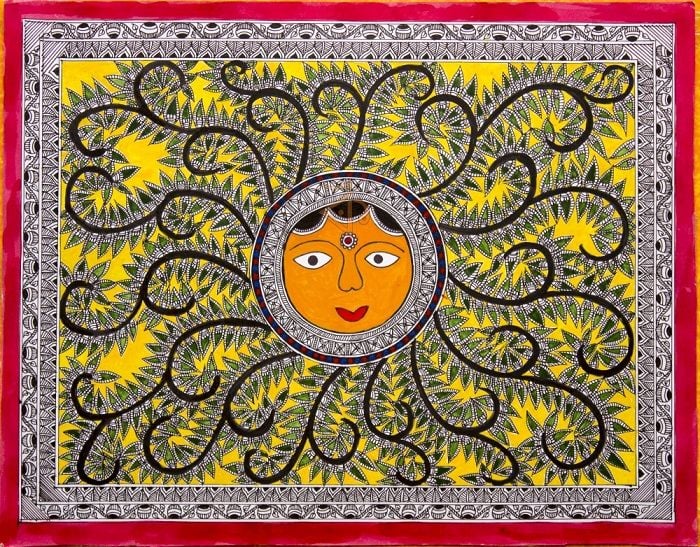
Image Credit : https://www.artzolo.com/traditional-art/sun-madhubani-painting?id=71024
Madhubani Painting
Madhubani painting is one of the many famous Indian art forms. As it is practiced in the Mithila region of Bihar and Nepal, it is called Mithila or Madhubani art. Often characterized by complex geometrical patterns, these paintings are known for representing ritual content for particular occasions, including festivals, religious rituals, etc. The colors used in Madhubani paintings are usually derived from plants and other natural sources. These colors are often bright and pigments like lampblack and ochre are used to create black and brown respectively. Instead of contemporary brushes, objects like twigs, matchsticks and even fingers are used to create the paintings.
History & Evolution
Madhubani paintings originated in the Mithila region of Bihar. Some of the initial references to the Madhubani painting can be found in the Hindu epic Ramayana when King Janaka, Sita’s father, asks his painters to create Madhubani paintings for his daughter’s wedding. The knowledge was passed down from generation to generation and the paintings began to adorn the houses of the region. The women of the village practiced these paintings on the walls of their respective home. Their paintings often illustrated their thoughts, hopes and dreams.
Over time, Madhubani paintings became a part of festivities and special events like weddings. Slowly, this art attracted connoisseurs of art as many contemporary Indian artists took the art on global stage. The traditional base of plastered mud wall was soon replaced by handmade paper, cloth and canvas. Since the paintings have been confined to a limited geographical range, the themes as well as the style are more or less, the same.
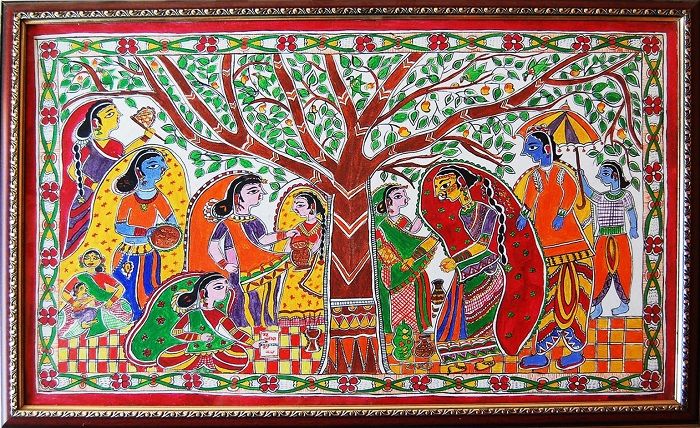
Image Credit : http://mpcrafts.com/product/madhubani-painting-king-queen-perform-worship-big/
Style & Designs
Madhubani paintings were initially practiced by different sects of people and hence the paintings were categorized into five different styles, such as Tantrik, Kohbar, Bharni, Godna, Katchni. But today, these five different styles have been merged by contemporary artists. The themes used in these paintings often revolve around Hindu deities like Krishna, Rama, Lakshmi, Shiva, Durga and Saraswati. Also, heavenly bodies like the Sun and the Moon often form the centerpiece of Madhubani paintings.
One can also find paintings based on the scenes from the royal courts and social events like weddings. The usage of geometrical patterns is pretty much apparent in these paintings. The fact that these complex mathematical patterns were used in Madhubani paintings makes them more intriguing and special.
These paintings are also known for their simplicity, for the brush and colors used are often derived from natural sources. While the paintings are largely made using powdered rice, colors derived from turmeric, pollen, pigments, indigo, various flowers, sandalwood, and leaves of various plants and trees, etc. Also, many natural sources are combined and are processed to obtain the desired colors. The colors are often prepared by the artists themselves. If the artists come across empty spaces even after completing the painting, they usually fill up those empty spaces with the motifs of flowers, animals, birds and geometrical patterns. A double line is usually drawn as the border.
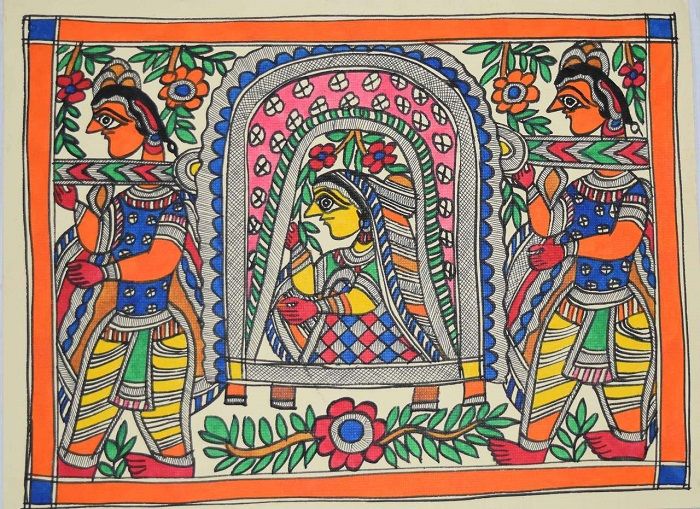
Image Credit :https://www.fizdi.com/madhubani-painting-art024-dulhan-in-doli-art_2168_24963-handpainted-art-painting-15in-x-11in/
Notable Madhubani Artists
This amazing art form is still kept alive because of the efforts of many artists who continue to practice Madhubani art. Many notable Madhubani artists have received national and international recognition. Some of them are mentioned below:
- Sita Devi – Though Madhubani paintings were being practiced many years ago by the womenfolk of Mithila, it was Sita Devi who brought this art form under the limelight. Sita Devi was honored with the State Award by the government of Bihar in the year 1969 and that is when this art form received national recognition. Sita Devi was born in the Jitwarpur village in the Madhubani district of Bihar. She was exposed to this age old painting right from her childhood. But it wasn’t until she received the State Award that the art form was recognized all over the country. In 1975, she was once again honored when the National Award was bestowed upon her by the President of India. In 1981, Padma Shri, the fourth highest civilian award of India, was conferred on Sita Devi. The government of Bihar then honored her with the prestigious Bihar Ratna in 1984. In 2006, the government of India conferred on her the title, Shilp Guru.
- Ganga Devi – Ganga Devi is another artist who is credited for popularizing Madhubani painting. Not just in India, but Ganga Devi popularized this ancient art form in foreign countries as well. Like Sita Devi, Ganga Devi too was exposed to Madhubani painting right from her childhood as she was born in Mithila, Bihar. She was born into the Kayastha community and practiced the Katchni style of painting. She then travelled to various countries in an attempt to popularize the art form all over the world. She even participated in ‘Festival of India,’ an event organized in the United States of America. In the event, she displayed her paintings and was appreciated by many international artists. For her efforts, the government of India honored her with the National Award for Crafts. In the year 1984, Ganga Devi was awarded Padma Shri by the President of India.
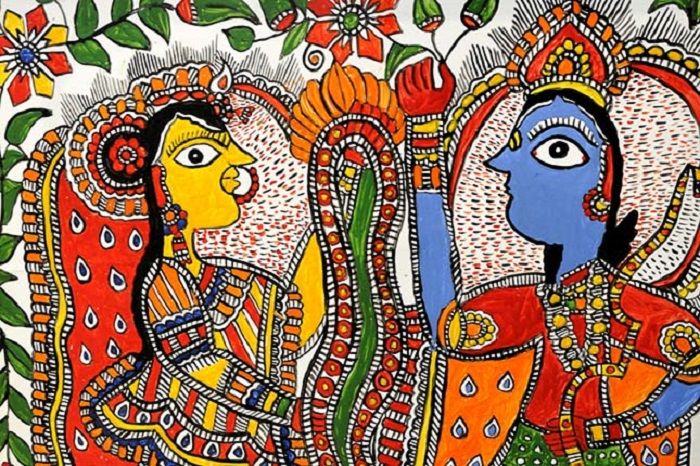
Image Credit : https://www.craftsvilla.com/blog/history-of-madhubani-art-paintings-will-leave-you-in-awe/
- Mahasundari Devi – Also born in Madhubani, Bihar, Mahasundari Devi was a renowned Madhubani artist. She started learning the art form from her aunt at a very young age. Mahasundari Devi played a key role in supporting and developing not just Madhubani painting but also various other art forms of Bihar by creating a cooperative society. She was considered a living legend and was honored with various prestigious awards. In 1982, the President of India honored her with the National Award. The Government of Madhya Pradesh then bestowed on her the prestigious Tulsi Samman in 1995. In 2011, she was honored with the Padma Shri by the Government of India. Mahasundari Devi breather her last on 4 July 2013, but left behind a great legacy. Bibha Das, her daughter-in-law, is an award-winning Madhubani painter as well.
- Bharti Dayal – Born in Samastipur, Bihar, Bharti Dayal learnt the traditional art form from her mother and her grandmother. Bharti strived to take the art form to the world stage and played a key role in the popularization of these paintings. In order to popularize the art form and propagate it throughout the world, she started using present day techniques and thereby contemporized the art form. She then displayed her works in various exhibitions throughout the world. In June 2016, her paintings were displayed at the Museum of Sacred Art (MOSA), Belgium. The director of MOSA, Martin Gurvich, appreciated her works and called her the ambassador of Madhubani painting in the modern world. In 1995, a documentary aired on a French television channel displayed her Madhubani paintings. In 2006, Bharti Dayal won the National Award for excellence in the art form. She has also been honored with various other awards like AIFACS and National Merit awards. She has also won many state awards.
- Jagdamba Devi - Jagdamba Devi is another important exponent of Madhubani paintings. She was given the Padma Shri award in 1975 for her contributions towards the art form. Other Madhubani painters like Shashi Kala Devi, Leela Devi, Bauwa Devi, Yamuna Devi, Bindeshwari Devi, Chandrakala Devi, Shanti Devi, Chano Devi, Godavari Dutta, Ambika Devi, Manisha jha and Chandrabhushan have also been honoured with national awards.
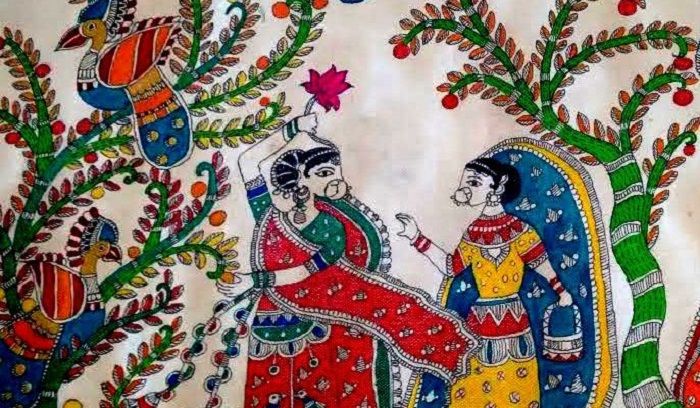
Image Credit : http://www.arteducation.in/2016/08/27/on-teaching-learning-folk-arts-madhubani-paintings/
Madhubani Painting in Modern Times
Madhubani art is an important part of the life of people in a village called Ranti in present day Bihar. The women who practice this art form in the village use it as an opportunity to create awareness on social issues and to empower women. Artists like Karpuri Devi, Mahalaxmi and Dulari are playing key roles in teaching other women the importance of Madhubani painting. Their works are displayed in a museum in Japan. Also, there are several institutions near Mithila that teach Madhubani paintings to young artists. Some of the major centers that teach this art form are Benipatti in Madhubani district, Gram Vikas Parishad in Ranti and Vaidehi in Madhubani. Artist Bharti Dayal owns a studio in New Delhi.
Comments
Post a Comment